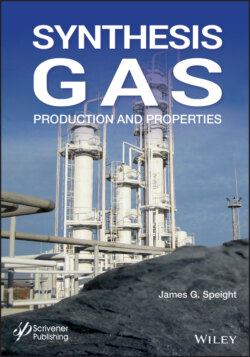Читать книгу Synthesis Gas - James Speight G., James G. Speight - Страница 61
2.6.1.3 High Btu Gas
ОглавлениеHigh Btu gas (heat-content gas) is essentially pure methane and often referred to as synthetic natural gas or substitute natural gas (SNG) (Kasem, 1979; c.f. Speight, 1990, 2013). However, to qualify as substitute natural gas, a product must contain at least 95% methane, giving an energy content (heat content) of synthetic natural gas on the order of 980 to 1080 Btu/ft3).
The commonly accepted approach to the synthesis of high heat-content gas is the catalytic reaction of hydrogen and carbon monoxide:
To avoid catalyst poisoning, the feed gases for this reaction must be quite pure and, therefore, impurities in the product are rare. The large quantities of water produced are removed by condensation and recirculated as very pure water through the gasification system. The hydrogen is usually present in slight excess to ensure that the toxic carbon monoxide is reacted; this small quantity of hydrogen will lower the heat content to a small degree.
The carbon monoxide/hydrogen reaction is somewhat inefficient as a means of producing methane because the reaction liberates large quantities of heat. In addition, the methanation catalyst is troublesome and prone to poisoning by sulfur compounds and the decomposition of metals can destroy the catalyst. Hydrogasification may be thus employed to minimize the need for methanation:
The product of hydrogasification is far from pure methane and additional methanation is required after hydrogen sulfide and other impurities are removed.
Synthetic natural gas (SNG) is methane obtained from the reaction of carbon monoxide or carbon with hydrogen. Depending on the methane concentration, the heating value can be in the range of high-Btu gases.
